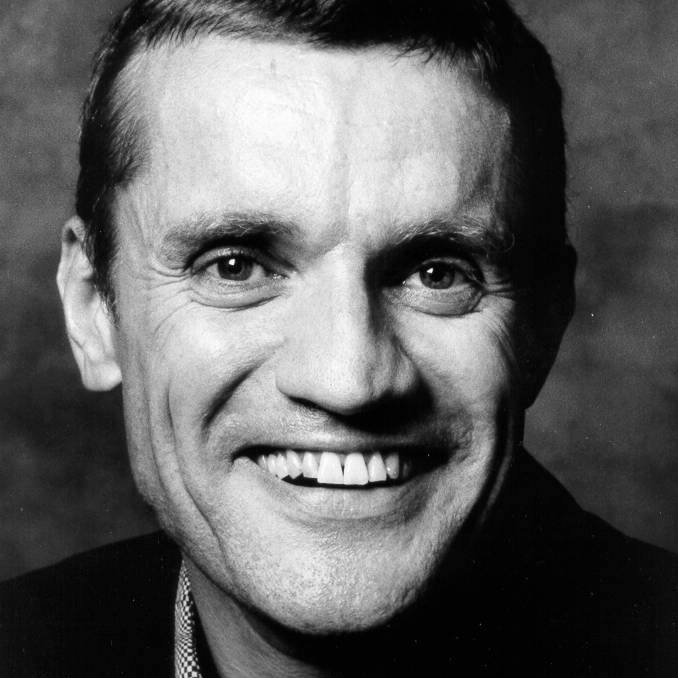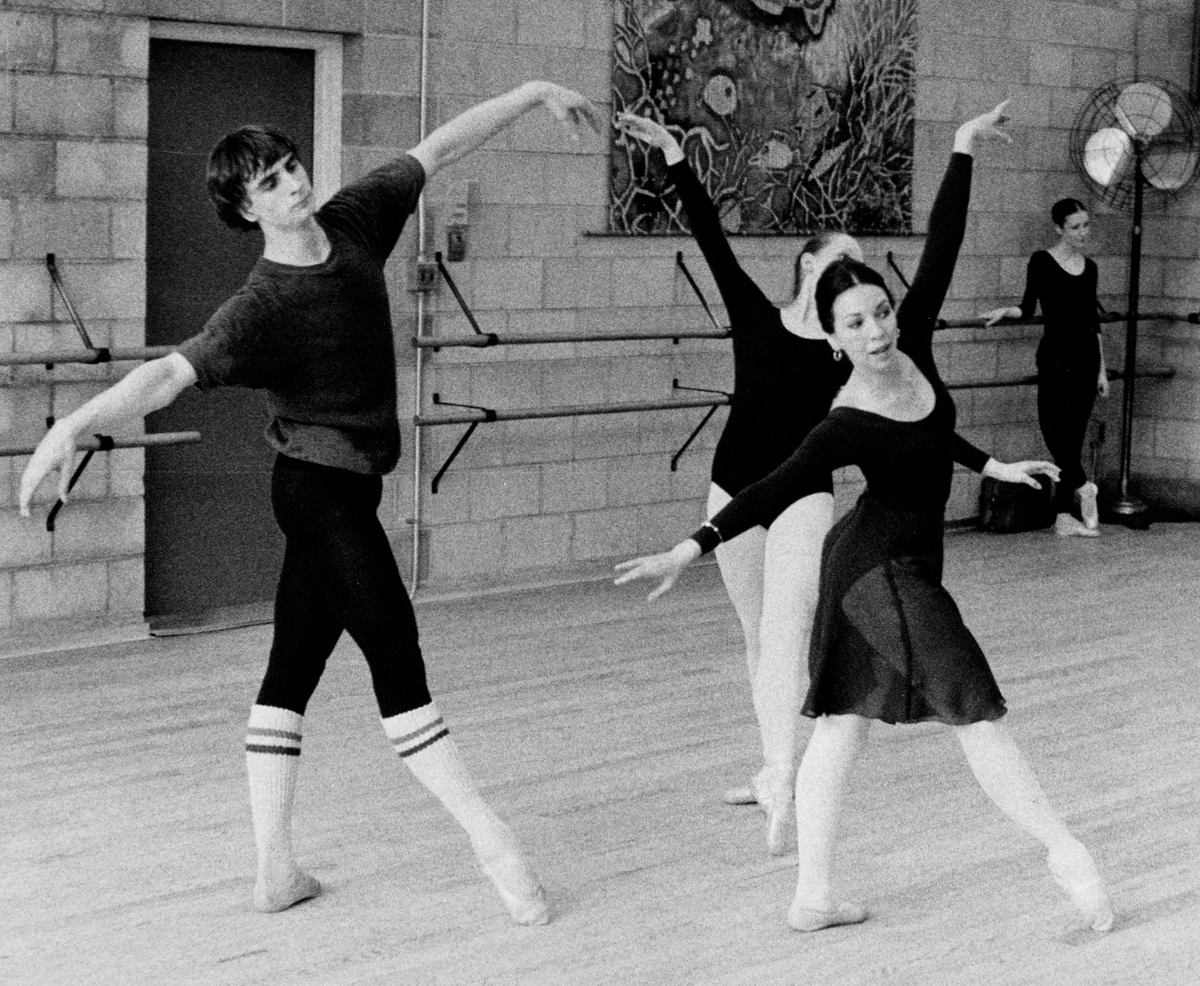THE ARTISTIC DIRECTORS’ VIEW ON BALANCHINE
BY JOYSANNE SIDIMUS, M.S.M.
The following perspectives accompany the article “Balanchine in Canada” by Balanchine repetiteur Joysanne Sidimus in issue 83, Fall 2023, of DCD Magazine. It consists of contributions only from those artistic directors who either included Balanchine ballets during their tenure or are currently planning to do so. The author is extremely grateful to the artistic directors for their generous time and insights.
Changing the Landscape
Balanchine in Canada
To download and read Joysanne Sidimus’ article from the 2023 edition of Dance Collection Danse Magazine, click on the button. To get your own copy and read the entire issue visit Here. OR join our mailing list to get a free digital copy.
Banner Photo Image: George Balanchine teaching, 1960s / Photo: Martha Swope, Dance in Canada Photo Collection, Dance Collection Danse
THE ARTISTIC DIRECTORS
Lynn Wallis & Valerie Wilder
Former Co-Artistic Directors (1986-1989)
The National Ballet of Canada


One of the first programs Erik Bruhn scheduled for The National Ballet of Canada at the start of his short (1983-1986) but extraordinary directorship was an all-Balanchine evening. Believing that a Balanchine presence in the repertoire was essential for the company and its dancers, Erik planned a stunning program of classic favourites: Serenade and Four Temperaments, already in the rep, and new to the company, Symphony in C. After the program had been performed it had an unexpected ripple effect over the next few years. Erik’s tenure and ours produced many successful new works which would go on to tour nationally and internationally at a level not seen since the Nureyev years in the ’70s and the anchor to many of these touring programs was Serenade as the opening ballet. Over time, the company and especially the female corps de ballet, came together for a truly magical start to many performances, often receiving accolades that would far exceed expectations. In addition, the benefits to the dancers of consistently performing Balanchine works could be seen across the breadth of all the repertoire.
Photo Credits: (left to right) Valerie Wilder, Former Co-Artistic Director. Photo by Cylla von Tiedemann. Courtesy of The National Ballet of Canada. Lynn Wallis, Former Co-Artistic Director. Photo by David Street. Courtesy of The National Ballet of Canada.
Reid Anderson
Former Artistic Director
Ballet BC (1986-1989)
The National Ballet of Canada (1989-1996)

I’ve always felt that Balanchine was a must in any classically based ballet company’s repertoire! John Cranko also felt this way as do most of the global heads of companies possessing the technical skills, movement quality and professionalism to execute the works with style, precision and class! A Balanchine piece ‘works’ in practically any triple bill! Dancers love to work on and perform his ballets! They are technically challenging; musically, a wonder; and rewarding, not only physically but also for the heart and soul!
Photo Credit: Reid Anderson, Former Artistic Director. Photo by Cylla von Tiedemann. Courtesy of The National Ballet of Canada.
James Kudelka, O.C.
Former Artistic Director (1996-2005)
The National Ballet of Canada

For me as a dancer, the Balanchine repertoire extended my technique and musicality. As a choreographer, Balanchine was about craft and architecture, the body, and the ensemble in space. Patterns, and the courage to meet the score on equal terms. As a director Balanchine is an extended education for the dancer, the choreographer, and the audience.
Photo Credit: James Kudelka
Karen Kain, C.C.
Artistic Director Emerita (since 2021)
Former Artistic Director (2005-2021)
The National Ballet of Canada

The inclusion of Balanchine in the repertoire provides not only a unique and amazing representation of the musical scores but provides dancers challenging opportunities both physically and musically. Balanchine makes the musical score visible to the audience.
Photo Credit: Karen Kain, 2019, photo by Juliana Reyes
Hope Muir
Joan and Jerry Lozinski Artistic Director (since 2021)
The National Ballet of Canada

George Balanchine had a unique perspective that engages choreographic discourse about and understanding of the past, present, and future of this artform. Well known for his plotless ballets and his distinctive approach to musical phrasing, Balanchine’s neoclassical works are inspiring and instructive for dancers and are essential to both the development of the artist and a contextual understanding of dance history. The National Ballet of Canada is fortunate to have 18 Balanchine works in our repertoire and as Artistic Director I am committed to keeping our artists and audiences connected to this prolific creator.
Photo Credit: Hope Muir, Joan and Jerry Lozinski Artistic Director. Photo by Karolina Kuras. Courtesy of The National Ballet of Canada.
Mavis Staines, C.M., DHumL
Artistic Director & CEO (since 1989)
Canada’s National Ballet School

Balanchine works are without question among the greatest works in the ballet canon and so here at NBS we regularly program them to enrich our Spring Showcase presentations. But that is not the only reason we include them in our programming. It is not even the primary reason. Preparing to present any Balanchine work brings our students into intimate contact with the most beautiful explorations of the classical ballet vocabulary and it demands of them precision, energy, and attention to the complexity of his choreographic response to music. Simply put, learning to dance Balanchine makes them better dancers. Just as he intended when creating Serenade for his first students in America, dancing his works also teaches them how “to be on a stage”, how to move from being students to artists. The transformations that we see in our students through their encounters with Balanchine ensure that his works will continue to be part of our regular programming.
Photo Credit: Mavis Staines, 2021, photo by Liliana Reyes
André Lewis, O.M.
Artistic Director & CEO (since 1995)
Royal Winnipeg Ballet

The RWB has a robust history of performing Balanchine that began as a conversation in 1962 between Sol Kanee, who at the time was one of the Vice-Presidents of the RWB Board and George Balanchine. Kanee was introduced to Balanchine in New York, and the choreographer expressed a desire to help the company in any way he could,(;?)the most obvious answer was a ballet. The first offer was Concerto Barocco, but Kanee wasn’t sure the RWB had the talent at that time, the second was Serenade, which had too many dancers, so the final offer was Pas de Dix and was the RWB’s introduction to Balanchine. From there, the RWB continued to incorporate Balanchine and as the company grew both in size and talent, Concerto Barocco debuted in 1988, Tarantella in 1988, and Serenade in 1996 among many others over the past 50 years. In order to perform one of the most influential 20th-century choreographer’s work, a company must be at their best, not only for a moment, but consistently over a long period of time. Incorporating Balanchine into the RWB’s repertoire demonstrates the dancers’ technical skills, but also their artistry.
Photo Credit: André Lewis, 2017, photo by Ian McCausland
Arlene Minkhorst
Former School Director (2004-2018)
Royal Winnipeg Ballet

I expect that any dancer who joins a professional ballet company will, at some point, be dancing something from the Balanchine repertoire. Having the opportunity to learn and perform these iconic works while in training not only prepares young dancers for their profession, but develops their technical, musical, and artistic skills. Each time our students have had the opportunity to work on a piece of Balanchine repertoire, I have so loved seeing the notable growth in them as young artists.
Photo Credit: Arlene Minkhorst, photo from the Jacob’s Pillow website
Stéphane Léonard
School Director
Royal Winnipeg Ballet (since 2018)

I strongly believe that it is essential for ballet students to be exposed to the Balanchine repertoire in workshops and or as training opportunities. Once a student is advanced and skilled enough to tackle some of the challenges and intricacies of the Balanchine repertoire, it is an invaluable experience that will undeniably serve the students in their future career as professional dancer. From a personal point of view, I only experienced the Balanchine repertoire as a professional dancer and company member. I wish I had the opportunity to study the style while I was a student. I found that I was ill prepared for the speed and accuracy required let alone the demands for impeccable musicality.
Photo Credit: Stéphan Léonard, photo by Kristen Sawatzky
Mikko Nissinen
Former Artistic Director (1998-2001)
Alberta Ballet

Balanchine’s works are a vital part of a ballet company’s repertoire. Bringing Allegro Brillante, Divertimento No. 15, Rubies, and Prodigal Son to Alberta Ballet was key to my mission as artistic director, since they provide superb neoclassical progression of the art form, exemplary dynamics, and great opportunities for dancers and audiences to experience Mr. Balanchine’s legendary choreography.
Photo Credit: Mikko Nissinen, photo by Liza Voll
Jean Grand-Maître
Former Artistic Director (2002-2022)
Alberta Ballet

George Balanchine saved ballet in the 20th century and made it not only an entertaining art form for a modern audience, but a highly intellectual exploration of esthetics as well. His revolutionary vision may have coincided with other dancemakers’ ideas but he surpassed them all in every way. From Prodigal Son to Apollo, to his Stravinsky Violin Concerto, his dance was always shockingly new. To this day, I find him as modern if not more so, than most choreographers working now. Take Forsythe’s The Second Detail for example, change the music to a highly syncopated score by Webern and you have Episodes on high adrenaline. When you have a program featuring a Balanchine ballet, you know your dancers will be more fit than ever, challenged and happier as well. As most ballets today require very little jumping and speed, compared to his own works, I believe that no other choreography, with the exception of the great classics from the 19th century, can challenge a dancer’s technique, endurance, musicality, and artistry more. Yes artistry, because I think that to be riveting and fascinating in abstract work, is more challenging for a dancer than a Shakespearean tragedy. Ballet companies are the caretakers of an art form in all of its eclectic incarnations, from the 19th century masterpieces to those of the 20th. Not programming Balanchine would be like an orchestra never playing Mozart. As the fads come and go, Balanchine will remain. Sometimes he may become less present, but he will never disappear as will dozens of his ballets.
Photo Credit: Jean Grand-Maître, photo from the Agence Goodwin website
Christopher Anderson
Co-Artistic Director with Jean Grand-Maître (2021/22 season)
Artistic Director (2022-2023)
Alberta Ballet

One of the remarkable things about Balanchine ballets is how they connect us. As repertoire becomes increasingly globalized and even more accessible, Balanchine’s ballets have long been available for companies and dancers across Canada and worldwide. It is something we all share and celebrate in our own cities and theatres.
Photo Credit: Christopher Anderson, photo from the Alberta Ballet website
Gradimir Pankov
Former Artistic Director (1999-2017)
Artistic Director Emeritus (since 2017)
Les Grands Ballets Canadiens de Montréal

I had my first exposure to the choreography of George Balanchine as a young dancer, in my native Yugoslavia. I had been trained in classical ballet but Mr. Balanchine’s work was a new experience for me. I was impressed by the cohesion between movement and music, and by Mr. Balanchine’s way of using classical ballet technique in a freer, more contemporary style of choreography.
Many decades later, when I became an artistic director, first in Europe and then with Les Grands Ballets Canadiens (LGBC), Balanchine ballets were included as an essential part of my programing. This was not just to please the public, but also to challenge our dancers to perfect their musicality and technical abilities. In particular with LGBC, our Balanchine repertoire ranged from the fascinating, although lesser-known Episodes, to the brilliance of Rubies and Concerto Barocco. A Balanchine ballet on the repertoire was always a great joy for our dancers to perform, as well as a guaranteed success with our audiences.
Photo Credit: Gradimir Pankov, photo by Jean Laurent Ratel
Ivan Cavalleri
Artistic Director
Les Grands Ballets Canadiens de Montréal (since 2017)

Balanchine is one of the most lauded choreographers of the 20th century. His exceptional attention to detail, innate musicality, and the emotional connection he makes to the music through his choreography, makes his work an essential ingredient for every company with a classical base. Further, the skill and physicality demanded of dancers performing his works, will ultimately propel a company forward.
Photo Credit: Ivan Cavalleri, photo by Sasha Onyshchenko
Anik Bissonnette, O.C., C.Q.
Directrice Artistique/Artistic Director
L’École supérieure de ballet du Québec

Enseigner le répertoire de Balanchine est absolument incontournable pour une institution de formation professionnelle en danse classique comme l’École supérieure de ballet du Québec. Pour les étudiants, il est à la fois enrichissant et valorisant de danser des œuvres de Balanchine, car cela demande de développer une grande précision technique tout en faisant appel à la vitesse et à la musicalité. Ce style, très formateur, traverse le temps et demeure d’une grande pertinence aujourd’hui.
Teaching Balanchine’s repertoire is absolutely essential for a professional training institution in classical dance such as L’École supérieure de ballet du Québec. For students, dancing Balanchine’s works is both enriching and rewarding, as it requires them to develop great technical precision while calling upon speed and musicality. This style, which is very formative, has stood the test of time and remains highly relevant today.
Photo Credit: Anik Bissonnette, photo by Carl Lessard
Lindsay Fischer
Former Artistic Director of the Apprentice Program at The National Ballet of Canada (2007-2021)
Former Director, Professional Summer Dance Program at the Banff Centre (2008-2015)

Balanchine’s ballets and his teaching practice emphasize three things that are vital for ballet: musical accuracy, physical accuracy, and intellectual accuracy. These are all different facets of the same construct, and are thus interdependent. Understanding these ideas requires analysis, putting them into practice requires synthesis. Ballet dancing in general is more interesting and relevant when it uses the body to illustrate abstract and otherwise ephemeral concepts; for Balanchine’s ballets this practice is essential. Therefore, if those of us who dance want ballet to be more than an art form that is merely the admiration of arbitrary, constructed, race-based physical beauty, and instead function as one that examines the use of real experience to illuminate ideal spiritual development, Balanchine is a valuable course of study.
Photo Credit: Lindsay Fischer, Former Principal Ballet Master. Photo by Aleksandar Antonijevic. Courtesy of The National Ballet of Canada.
ACKNOWLEDGEMENTS
In addition to the Artistic Directors, the author would like to thank the following for their generous and knowledgeable help:
Allan Altman
Carol Anderson
Christiana Bennett
Jennifer Bennett
Tara Birtwhistle
Amy Bowring
Nicole Cornell
Gayle DeGagne
Anne-Marie Dubreuil
Cheryl Epstein
Suzanne Farrell
Vanessa Harwood
Evelyn Hart
Barbara Horgan
Marie-Josée Lecours
Nicole Montano
Jeff Morris
Elizabeth Olds
Patricia Neary
Margret Pankov
Francois Pomminville
Nancy Reynolds
Francia Russell
Victoria Simon
Mary Ann West
Katie Wilson
Joysanne Sidimus has been a Balanchine repetiteur for The George Balanchine Trust for over 40 years and recently retired from the National Ballet of Canada in that capacity for 38 years. She was trained at the School of American Ballet, danced with the New York City Ballet and was a Principal Dancer of the National Ballet of Canada and the Pennsylvania Ballet.

PERSONNEL
Miriam Adams, C.M.
Co-founder/Advisor
Amy Bowring
Executive and Curatorial Director
Jay Rankin
Administrative Director
Vickie Fagan
Director of Development and Producer/Hall of Fame
Elisabeth Kelly
Archives and Programming Coordinator
Michael Ripley
Marketing & Sales Coordinator
CONTACT
1303 – 2 Carlton St.
Toronto, ON
M5B 1J3
Canada
Phone: 416-365-3233
Fax: 416-365-3169
info [AT] dcd.ca
HOURS
Mon. – Fri. 10 a.m. – 5 p.m.
Appointment Required
Contact our team by email or call one of the numbers above







